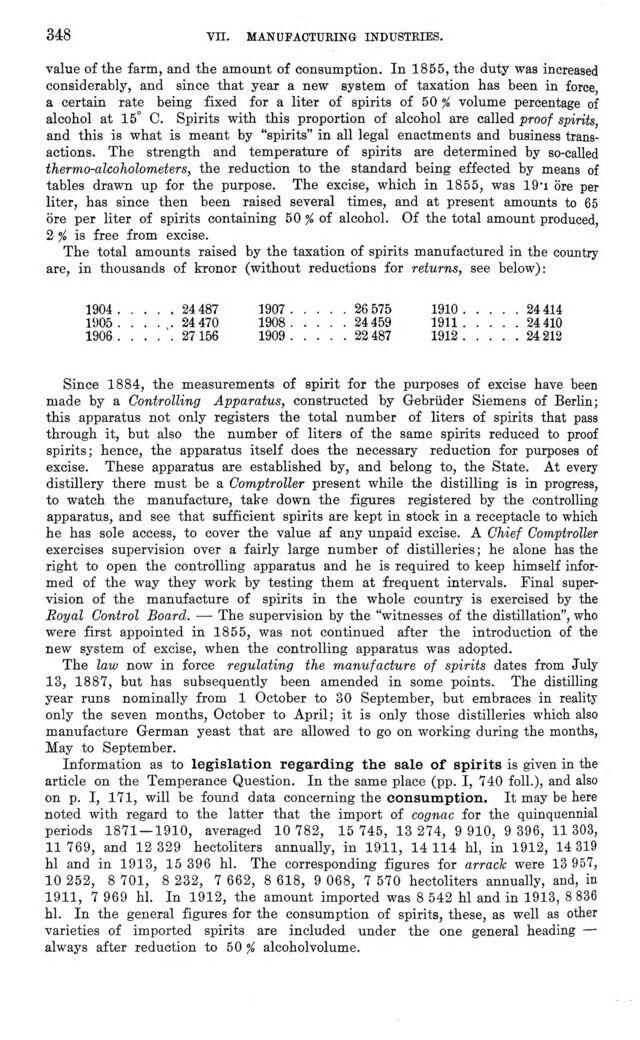
Full resolution (JPEG) - On this page / på denna sida - VII. Manufacturing Industries. Introd. by [G. Sundbärg] K. Åmark - 1. Articles of Food and Consumption. Introd. by Alf. Larson - Spirit Production. By Å. G. Ekstrand

<< prev. page << föreg. sida << >> nästa sida >> next page >>
Below is the raw OCR text
from the above scanned image.
Do you see an error? Proofread the page now!
Här nedan syns maskintolkade texten från faksimilbilden ovan.
Ser du något fel? Korrekturläs sidan nu!
This page has never been proofread. / Denna sida har aldrig korrekturlästs.
348
vn. manufacturing industries.
value of the farm, and the amount of consumption. In 1855, the duty was increased
considerably, and since that year a new system of taxation has been in force,
a certain rate being fixed for a liter of spirits of 50 % volume percentage of
alcohol at 15° C. Spirits with this proportion of alcohol are called proof spirits,
and this is what is meant by "spirits" in all legal enactments and business
transactions. The strength and temperature of spirits are determined by so-called
thermo-alcoholometers, the reduction to the standard being effected by means of
tables drawn up for the purpose. The excise, which in 1855, was 19’i ore per
liter, has since then been raised several times, and at present amounts to 65
ore per liter of spirits containing 50 % of alcohol. Of the total amount produced,
2 % is free from excise.
The total amounts raised by the taxation of spirits manufactured in the country
are, in thousands of kronor (without reductions for returns, see below):
Since 1884, the measurements of spirit for the purposes of excise have been
made by a Controlling Apparatus, constructed by Gebriider Siemens of Berlin;
this apparatus not only registers the total number of liters of spirits that pass
through it, but also the number of liters of the same spirits reduced to proof
spirits; hence, the apparatus itself does the necessary reduction for purposes of
excise. These apparatus are established by, and belong to, the State. At every
distillery there must be a Comptroller present while the distilling is in progress,
to watch the manufacture, take down the figures registered by the controlling
apparatus, and see that sufficient spirits are kept in stock in a receptacle to which
he has sole access, to cover the value af any unpaid excise. A Chief Comptroller
exercises supervision over a fairly large number of distilleries; he alone has the
right to open the controlling apparatus and he is required to keep himself
informed of the way they work by testing them at frequent intervals. Final
supervision of the manufacture of spirits in the whole country is exercised by the
Royal Control Board. — The supervision by the "witnesses of the distillation", who
were first appointed in 1855, was not continued after the introduction of the
new system of excise, when the controlling apparatus was adopted.
The law now in force regulating the manufacture of spirits dates from July
13, 1887, but has subsequently been amended in some points. The distilling
year runs nominally from 1 October to 30 September, but embraces in reality
only the seven months, October to April; it is only those distilleries which also
manufacture German yeast that are allowed to go on working during the months,
May to September.
Information as to legislation regarding the sale of spirits is given in the
article on the Temperance Question. In the same place (pp. I, 740 foil.), and also
on p. I, 171, will be found data concerning the consumption. It may be here
noted with regard to the latter that the import of cognac for the quinquennial
periods 1871 — 1910, averaged 10 782, 15 745, 13 274, 9 910, 9 396, 11 303,
11 769, and 12 329 hectoliters annually, in 1911, 14 114 hi, in 1912, 14 319
hi and in 1913, 15 396 hi. The corresponding figures for arrack were 13 957,
10 252, 8 701, 8 232, 7 662, 8 618, 9 068, 7 570 hectoliters annually, and, in
1911, 7 969 hi. In 1912, the amount imported was 8 542 hi and in 1913, 8 836
hi. In the general figures for the consumption of spirits, these, as well as other
varieties of imported spirits are included under the one general heading —
always after reduction to 50 % alcoholvolume.
1904 ..... 24 487
1905 ..... 24 470
1906 ..... 27 156
1907 ..... 26 575
1908 ..... 24 459
1909 ..... 22 487
1910 ..... 24 414
1911 ..... 24 410
1912 ..... 24 212
<< prev. page << föreg. sida << >> nästa sida >> next page >>